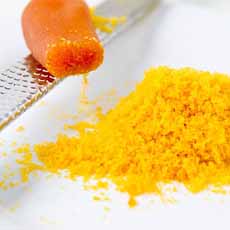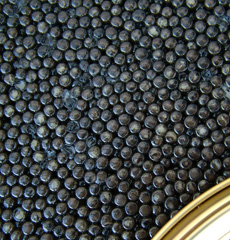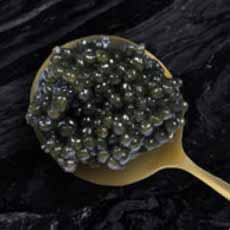Caviar Glossary: A Glossary Of The Different Caviar TypesPage 6: Caviar Glossary L To O This is Page 6 of an 10-page article. Click on the red links below to visit other pages. This glossary is protected by copyright and cannot be reproduced in whole or part. You are welcome to link to it.
|
 Pricey combo: toro tartare topped with osetra caviar. Photo courtesy Catch NYC. |
|
| MALOSSOL Roe does not officially become caviar until it is salted. The Russian term for “little salt,” referring to a method of delicately salting fine caviar. The less salt, the better the caviar; similarly, better-quality caviar requires less salting, so malossol indicates the best. Less salt also makes the caviar more perishable. Malossol is as little as 3.5% salt (by weight), up to 5%; compared to 10% for commercial barrel-salted caviar or 11% for supermarket lumpfish caviar. Salt preserves the freshness and also enhances the flavor.
|
 The word “malossol” on the tin indicates that little salt has been used to process the caviar. This implies a finer caviar, where the taste does not need much enhancement. Photo courtesy CaviarMore.com. |
|
| MASAGO or MASAGO CAVIAR or ROE Also called capelin caviar or smelt roe: roe from the smelt fish, which lives in the northern Atlantic and Artic oceans. The eggs are small, fluorescent, mild in flavor, have less crunch and are less expensive (for good reason) than the tastier tobiko. Even their color is dull, and the eggs are typically colored before packaging. Masago roe are best used a garnish for California rolls and other rolls, shown in the photo at the top of the page and to garnish other foods, including deviled eggs.
|
 Masago, tiny eggs from the smelt, are best used as a garnish for their color. Photo by Lekyu | SXC. |
|
| MULLET ROE or KARASUMI
Mullet roe is not served as caviar or roe. Rather, like Italian bottarga, the roe sac is cured, dried and pressed into a block that can be sliced for hors d"™oeuvre, grated onto pasta, salads or fish, etc. Here"™s more about it, and ways to use it, from No Recipes.
|
 A block of mullet roe, grated as a garnish. Photo by No Recipes. |
|
| NACCARII CAVIAR Acipenser naccarii is a cousin of Caspian caviar. The fish swam in prehistory in the rivers of what is now Spain. It has intramuscular fat, which makes the meat more flavorful. Its light grey eggs are most likened to Beluga caviar, although it is a much smaller fish. The largest beluga ever measured weighed 3,463 pounds with a length of 23.6 feet. Naccarii can grow to 100 kilos, although commercially it is farmed to 8 to 20 kilos in weight. They begin harvesting at 18 years of age, If you see Beluga caviar for sale, confirm if it is Caspian Beluga or Spanish Naccarii.
|
 Naccarii caviar. Photo courtesy The Rogers Collection. |
|
| ORGANIC CAVIARAt this time the world’s only certified organic caviar farm, Riofrio Caviar Farm in the Sierra Nevada region of southern Spain, produces its caviar from the Adriatic sturgeon (Acipenser naccarii). Riofrio’s is considered the only true organic caviar farm because unlike most other sturgeon fisheries, no hormones are introduced to the controlled environment to speed up the maturity rate of the fish. The fish are also contained in pens with fresh mountain water that is untreated with additives (e.g., antibacterials). It gets high grades for the quality, based on the stock selection, breeding process, clean living environment, freshness and overall quality.
Sold under the brand name Pure Organic Caviar, it is prepared with organic salt in the traditional malossol style.
|
 Organic caviar is available at CaviarStar.com. |
|
| OSETRA or OSSETRA or OSCIETRA CAVIAR
The Osetra sturgeon or Russian Sturgeon (Acipenser gueldenstaedtii) is a migratory fish which spawns in rivers each spring. It is a medium-size sturgeon, and can weigh up to 440 pounds. The female does not mature to produce eggs for 12 to 15 years. The species is native to Germany’s major rivers, and the osetra sturgeon was a banquet fish for royalty throughout the Middle Ages. The caviar has a gentle pop and a light, nutty flavor (hazelnut) that pairs well with Champagne, Grüner Veltliner and Riesling. The word ossetra is the transcription of the Russian word ????? (osiotr), which translates into English as sturgeon. The word is variously transliterated as ascietra, asetra, osietra, ossetra and other spellings. At one time, the term "œossetra" simply referred to Russian sturgeon species harvested for this type of caviar. For the purpose of buying caviar, though, clarify that “osetra caviar” is Russian sturgeon caviar or one of the farmed varieties (typically its cousin Acipencer baerii baerii, the Siberian sturgeon). See a longer discussion of this confusing term. Osetra has an oilier, silkier, melts-in-your-mouth texture than Beluga. Many caviar connoisseurs prefer Osetra to Beluga (including us!). Wild Osetra caviar is harvested mainly in Russian and Iran; it is farmed around the world.* The eggs can be golden yellow (see Golden Osetra) to brownish in color, and are of medium size (about 3mm diameter). Osetra from the Caspian is packaged with a yellow lid. Recently we have seen various types of farmed Baerii and other sturgeon caviar packaged in the blue tin of the Beluga.
(See the note under Beluga about the 2006 ban on export of Russian caviar.) Continue To Next Page: Caviar Terms With P
|
 Osetra on a gold spoon. Photo courtesy Khavyar.
|
Last Updated Apr 2018
© Copyright 2005-2025 Lifestyle Direct, Inc. All rights reserved. All images are copyrighted to their respective owners.
